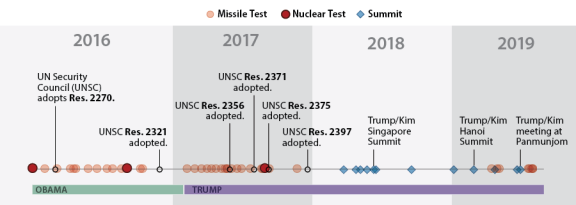Timeline of North Korean Nuclear and Missile Tests,
U.N. Sanctions, and Major Summits

Derived from various publications. Missile tests include long-range, medium-range, and short-range missiles.
Since President Trump agreed in March 2018 to hold a summit with North Korean leader Kim Jong-un to discuss North Korea's nuclear and missile programs, the Trump Administration's strategy has appeared to be based on the presumption that developing a leader-to-leader relationship will produce more results than the working-group approaches taken by previous administrations. Trump and Kim have held three meetings: in Singapore (June 2018); Hanoi (February 2019); and Panmunjom (June 2019). Since March 2018, Kim also has met on five occasions with Chinese President Xi Jinping, three with South Korean President Moon Jae-in, and one with Russian President Vladimir Putin.
Overall, these diplomatic efforts have produced a marked reduction in tensions on the Korean Peninsula, and Trump and Kim appear to have developed a personal relationship that Trump says ultimately could produce a breakthrough. Kim has pledged to denuclearize, and has maintained a unilateral moratorium on nuclear tests and long-range and medium-range missile tests.
Kim's public denuclearization promises, however, have been conditional and vague. North Korea has done little to dismantle its nuclear program and appears to be advancing its military capabilities. In addition to continuing to produce fissile material, since May 2019 North Korea has conducted multiple short-range ballistic missile (SRBM) tests, which violate United Nations prohibitions, apparently attempting to advance its solid fuel and guidance systems and develop capabilities to thwart short-range missile defense systems.
U.S. and DPRK positions do not appear to have moved closer to each other since the February 2019 Hanoi summit ended without an agreement due to differences over the scope and sequencing of concessions, specifically DPRK denuclearization measures in exchange for sanctions relief. The two countries have yet to agree upon a definition of denuclearization; whether and when North Korea will identify and declare all its nuclear weapons-related stocks and related facilities; if an agreement will include North Korean missiles, chemical weapons, biological weapons, and/or conventional forces; and the mechanisms for verifying any agreement, including inspection and monitoring arrangements. China, Russia, and to a lesser extent South Korea have called for a relaxation of sanctions on North Korea.
At Panmunjom in June 2019, Trump and Kim agreed to restart talks, but as of early August none had been held. North Korea said it would not to enter talks if the United States and South Korea proceeded with joint military exercises that commenced on August 5. The exercises are significantly reduced in scope due to President Trump's decision following the June 2018 Singapore summit to cancel larger-scale bilateral exercises. Trump's order, combined with his stated skepticism of alliances and demands for steep increases in allies' contributions to the costs of hosting U.S. troops, have raised questions in South Korea and Japan about the reliability and durability of U.S. security commitments.
Looking ahead, U.S. negotiators face the question of whether to aim for incremental dismantlement of North Korea's WMD programs in step with gradual sanctions relief, or to try for a "big deal" and demand complete denuclearization in exchange for full sanctions relief. A related question is whether the Administration would accept partial denuclearization as an outcome of talks, and what specifically such a bargain would entail. The possibility of full sanctions relief in exchange for denuclearization could reduce the number of tools available to challenge North Korea on other issues, including human rights, money laundering, and its cyberspace activities.
North Korea's Nuclear and Missile Programs
Diplomatic and Economic Developments
Military Developments
Other Developments
|
Timeline of North Korean Nuclear and Missile Tests, U.N. Sanctions, and Major Summits |
 |
|
Derived from various publications. Missile tests include long-range, medium-range, and short-range missiles. |